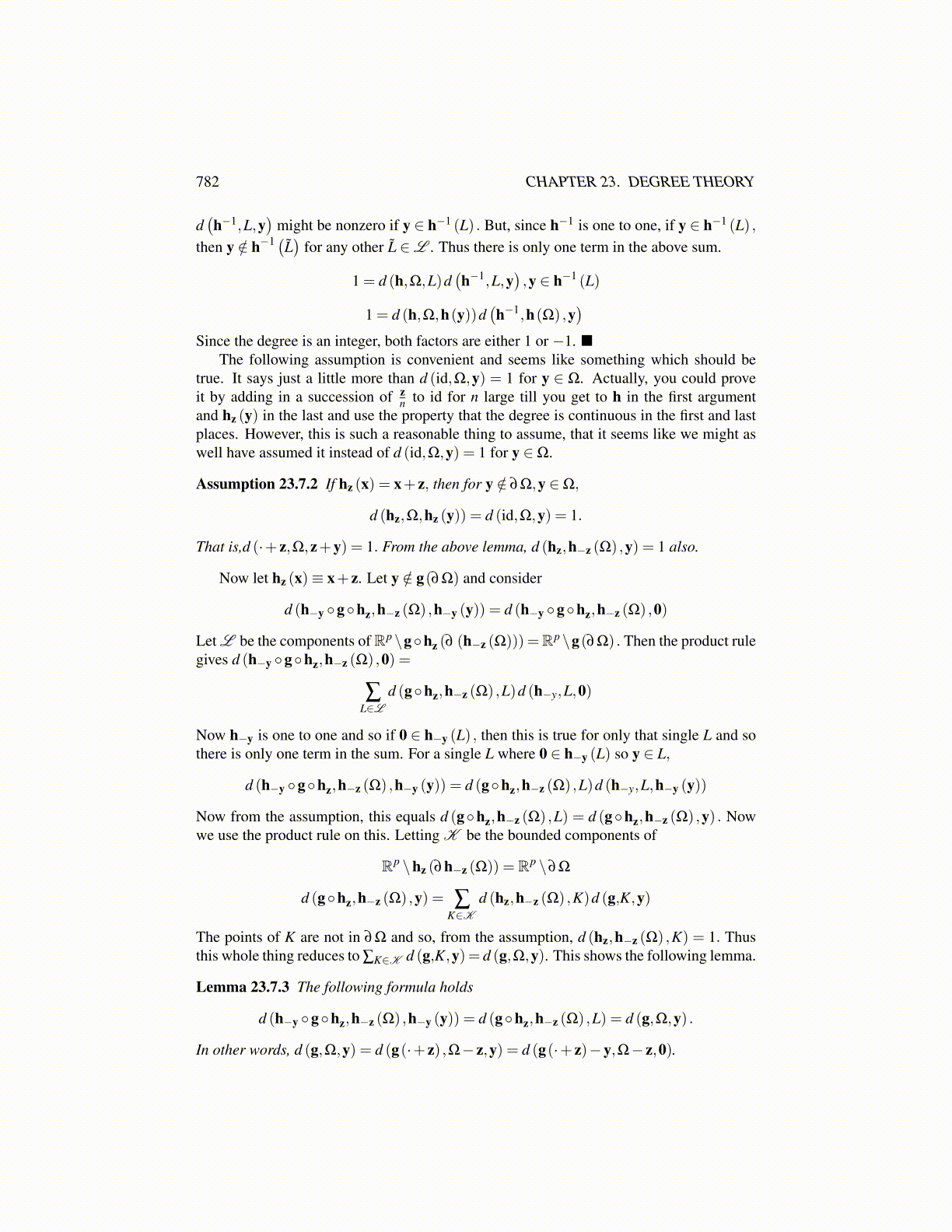
782 CHAPTER 23. DEGREE THEORY
d(h−1,L,y
)might be nonzero if y ∈ h−1 (L) . But, since h−1 is one to one, if y ∈ h−1 (L) ,
then y /∈ h−1 (L̃) for any other L̃ ∈L . Thus there is only one term in the above sum.
1 = d (h,Ω,L)d(h−1,L,y
),y ∈ h−1 (L)
1 = d (h,Ω,h(y))d(h−1,h(Ω) ,y
)Since the degree is an integer, both factors are either 1 or −1.
The following assumption is convenient and seems like something which should betrue. It says just a little more than d (id,Ω,y) = 1 for y ∈ Ω. Actually, you could proveit by adding in a succession of z
n to id for n large till you get to h in the first argumentand hz (y) in the last and use the property that the degree is continuous in the first and lastplaces. However, this is such a reasonable thing to assume, that it seems like we might aswell have assumed it instead of d (id,Ω,y) = 1 for y ∈Ω.
Assumption 23.7.2 If hz (x) = x+ z, then for y /∈ ∂Ω,y ∈Ω,
d (hz,Ω,hz (y)) = d (id,Ω,y) = 1.
That is,d (·+ z,Ω,z+y) = 1. From the above lemma, d (hz,h−z (Ω) ,y) = 1 also.
Now let hz (x)≡ x+ z. Let y /∈ g(∂Ω) and consider
d (h−y ◦g◦hz,h−z (Ω) ,h−y (y)) = d (h−y ◦g◦hz,h−z (Ω) ,0)
Let L be the components ofRp \g◦hz (∂ (h−z (Ω))) =Rp \g(∂Ω) . Then the product rulegives d (h−y ◦g◦hz,h−z (Ω) ,0) =
∑L∈L
d (g◦hz,h−z (Ω) ,L)d (h−y,L,0)
Now h−y is one to one and so if 0 ∈ h−y (L) , then this is true for only that single L and sothere is only one term in the sum. For a single L where 0 ∈ h−y (L) so y ∈ L,
d (h−y ◦g◦hz,h−z (Ω) ,h−y (y)) = d (g◦hz,h−z (Ω) ,L)d (h−y,L,h−y (y))
Now from the assumption, this equals d (g◦hz,h−z (Ω) ,L) = d (g◦hz,h−z (Ω) ,y) . Nowwe use the product rule on this. Letting K be the bounded components of
Rp \hz (∂h−z (Ω)) = Rp \∂Ω
d (g◦hz,h−z (Ω) ,y) = ∑K∈K
d (hz,h−z (Ω) ,K)d (g,K,y)
The points of K are not in ∂Ω and so, from the assumption, d (hz,h−z (Ω) ,K) = 1. Thusthis whole thing reduces to ∑K∈K d (g,K,y)= d (g,Ω,y). This shows the following lemma.
Lemma 23.7.3 The following formula holds
d (h−y ◦g◦hz,h−z (Ω) ,h−y (y)) = d (g◦hz,h−z (Ω) ,L) = d (g,Ω,y) .
In other words, d (g,Ω,y) = d (g(·+ z) ,Ω− z,y) = d (g(·+ z)−y,Ω− z,0).